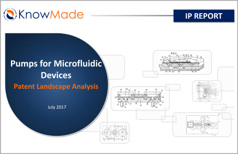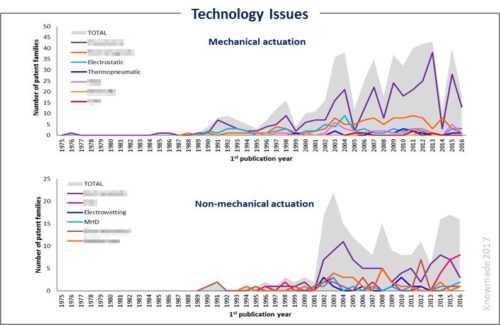
Mechanical pumps are the main patented technologies, but some non-mechanical pumps are in advanced development for emerging applications
Publication July 2017
| Download Flyer | Download Sample |
Report’s Key Features

- PDF >115 slides
- Time evolution of patent publications and countries of patent filings
- Current legal status of patents
- Ranking of main patent applicants
- Joint developments and IP collaboration network
- Key patents and granted patents near expiration
- Relative strength of the main companies’ IP portfolios
- IP profiles of 21 major companies
- The report also provides an extensive Excel database with all patents analyzed in the study
Related IP Reports developed by our team of experts in the medical sector. KnowMade produces several types of patent analyses such as patent landscape reports.
Pumping system: the heart of the microfluidic device
 The worldwide market for pumps for microfluidic devices is growing quickly. Pumps are the cornerstone of microfluidic systems. They are the key component that allows the motion of fluids in an accurate and reliable manner through a device’s reservoirs, chambers and microchannels. According to Market Research Future, the global micropump market should reach $5.28 billion by 2027, with a compound annual growth rate (CAGR) of 17.2%. The biomedical and pharmaceutical industries are driving the market. Micropumps are essential in DNA chips, lab-on-a-chip and drug delivery. They are also used in other domains, including flow chemistry, inkjet printing or electronic cooling. The intellectual property (IP) landscape related to pumps for microfluidic devices involves both industrial applicants like Epson, Baxter, Debiotech, Honeywell and Medtronic, and academic ones like Caltech, Stanford and Fraunhofer. This indicates that technologies for micropumps are still in development. This development is driven in particular by an increasing number of biomedical devices but also by the increasing need for micropumping systems for microelectronic components. To match all the various applications, many different technologies have been developed. Mechanical pumps include electrostatic, electromagnetic, piezoelectric, thermopneumatic, shape memory alloy, bimetallic and ion polymer conducting film technology. Non-mechanical pumps include magneto-hydrodynamic, electro-hydrodynamic, electroosmotic, electrowetting, electrochemical and bubble-type. This patent landscape report analyzes IP activity for each technology. The analysis of the technical issues addressed by patents related to pumps for microfluidic devices supports what we observe in the market. Mechanical pumps dominate, but new applicants, in particular from China, could accelerate the development of non-mechanical pumps for microfluidics.
The worldwide market for pumps for microfluidic devices is growing quickly. Pumps are the cornerstone of microfluidic systems. They are the key component that allows the motion of fluids in an accurate and reliable manner through a device’s reservoirs, chambers and microchannels. According to Market Research Future, the global micropump market should reach $5.28 billion by 2027, with a compound annual growth rate (CAGR) of 17.2%. The biomedical and pharmaceutical industries are driving the market. Micropumps are essential in DNA chips, lab-on-a-chip and drug delivery. They are also used in other domains, including flow chemistry, inkjet printing or electronic cooling. The intellectual property (IP) landscape related to pumps for microfluidic devices involves both industrial applicants like Epson, Baxter, Debiotech, Honeywell and Medtronic, and academic ones like Caltech, Stanford and Fraunhofer. This indicates that technologies for micropumps are still in development. This development is driven in particular by an increasing number of biomedical devices but also by the increasing need for micropumping systems for microelectronic components. To match all the various applications, many different technologies have been developed. Mechanical pumps include electrostatic, electromagnetic, piezoelectric, thermopneumatic, shape memory alloy, bimetallic and ion polymer conducting film technology. Non-mechanical pumps include magneto-hydrodynamic, electro-hydrodynamic, electroosmotic, electrowetting, electrochemical and bubble-type. This patent landscape report analyzes IP activity for each technology. The analysis of the technical issues addressed by patents related to pumps for microfluidic devices supports what we observe in the market. Mechanical pumps dominate, but new applicants, in particular from China, could accelerate the development of non-mechanical pumps for microfluidics.
Identify key players
The report provides a ranking and analysis of the relative strength of the top patent holders derived from their portfolio size, patent citation networks, countries of patent filings and current legal status of patents. Through this in depth analysis, we have identified 20+ major players. Each of those players is profiled in this report. The profiles include a detailed portfolio analysis with patent activities, key patents, impact of the company’s portfolio, granted patents near expiration and IP strategies. The IP landscape for pumps for microfluidic devices is driven by American applicants. But a few European applicants also have interesting IP assets.
Identify key technologies
This IP landscape for pumps for microfluidic devices reveals the key patents in this domain, as well as the pump technology they are related to. Two technologies were a particular focus for patent applicants: piezoelectric and electroosmotic technologies. However, recently, Chinese patent applicants started to show a strong interest for electrohydrodynamic pumps.
Key players: IP profile and key patents
The patent landscape related to pumps for microfluidic devices provides a detailed profile for each key player, including portfolio size, filing countries, leadership assessment as well as a selection of key patents. This analysis reveals that most of the key players are focused in the same mechanical technology: piezoelectric technology. However several key players show more interest in non-mechanical pumps, including Intel, Stanford, and MIT. This report also includes an Excel database containing all of the analyzed patents. The database allows for multi-criteria searches and includes patent publication numbers, hyperlinks to the original documents, priority dates, titles, abstracts, patent assignees and legal status for each member of the patent family.
Companies and academics cited in the report (non-exhaustive)
Agilent Technologies, Baxter International, Bigfoot Biomedical, Bosch, Caltech, Debiotech, Epson, Fraunhofer, Hitachi, Honeywell, Intel, ITRI, Konica Minolta, Medtronic, MIT, Panasonic, Roche, Seiko Instruments, Stanford University, University of California, Waters Corporation, etc.
